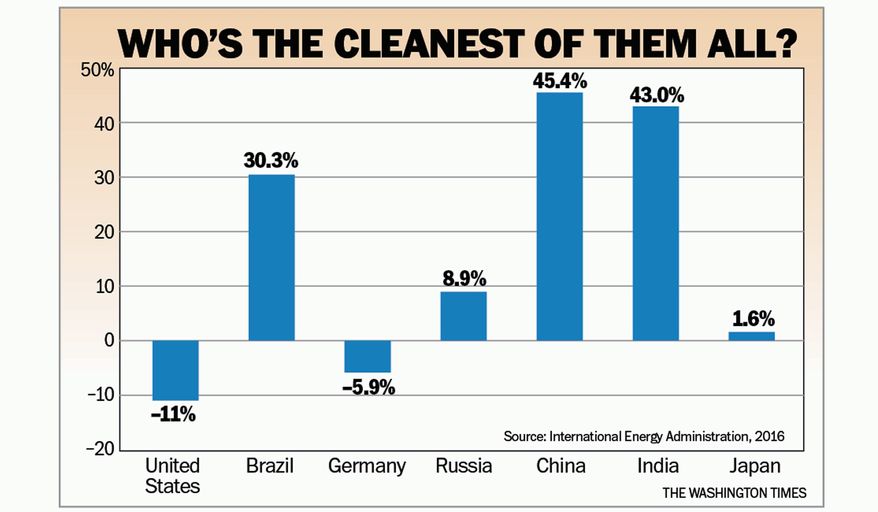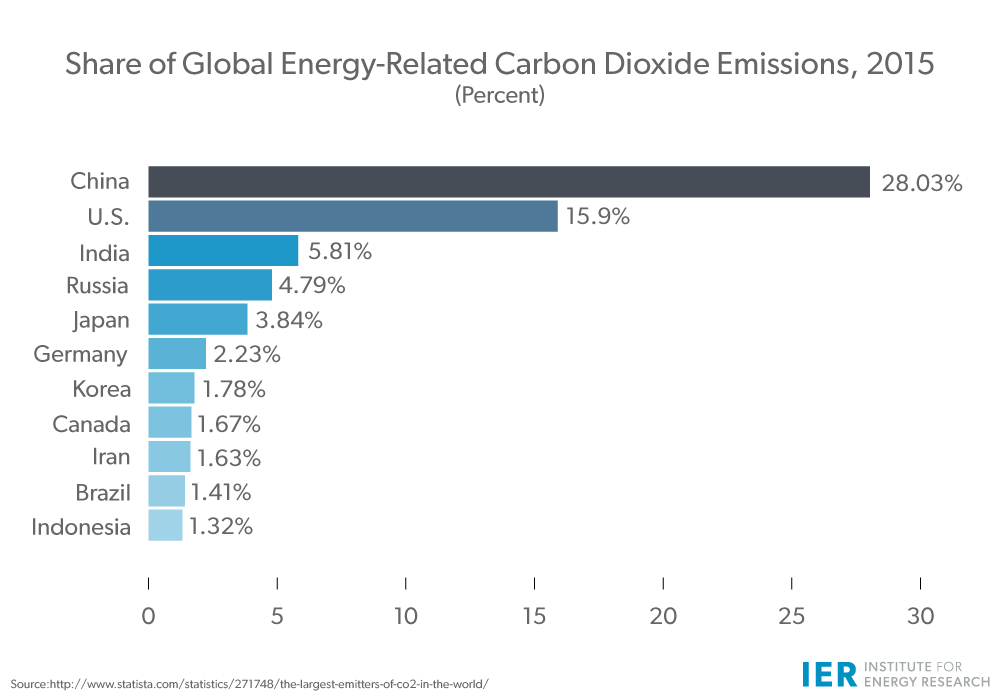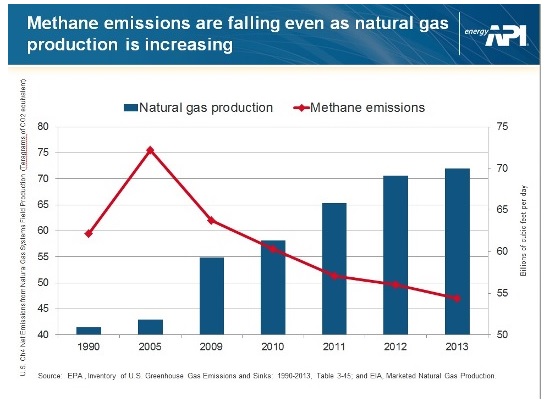According to the Energy Information Administration (EIA), U.S. carbon dioxide emissions were 2.5 percent less in 2015 than in 2014. In fact, since 2007, when they peaked, carbon dioxide emissions in the United States have been reduced by 12.2 percent. According to the Washington Times, the United States has reduced its carbon dioxide emissions more than virtually any other nation in the world.[i] For comparison, the European Union, which has spent $1.2 trillion on support for wind, solar and bio-energy, increased its carbon dioxide emissions by 0.7 percent in 2015 over 2014 levels. The biggest increase was in Belgium, where carbon dioxide emissions increased by 4.7 percent.[ii]
The U.S. achievement is not due to the Obama administration policies that will end up costing Americans plenty in the future. In reality, it’s thanks to the development of hydraulic fracturing, and its use in producing natural gas from shale formations, such as the Marcellus in Pennsylvania. Unfortunately, both Democratic candidates (Hillary Clinton and Bernie Sanders) are against hydraulic fracturing, despite the carbon dioxide reductions it has produced.
Source: Washington Times, http://www.washingtontimes.com/multimedia/image/4_102016_moore-chart-0411-208201jpg/
Failed European Policies
The European Union has formulated policies against the use of hydraulic fracturing, has provided substantial support for the development of intermittent wind and solar technologies and biofuels, and has incorporated carbon reduction programs to reduce carbon dioxide emissions. As a result, the average European pays 26.9 cents per kilowatt-hour for electricity—more than 2.5 times the average cost to a U.S. consumer. Denmark, which generates almost 40 percent of its generation from wind[iii], and Germany, which generates almost 33 percent from renewable energy[iv], have the highest electricity bills in Europe, paying about 39 cents per kilowatt-hour because of their support for “green energy.” These policies have not provided them with the environmental benefits they expected. As a result, these countries are now backing away from green energy. Denmark, for example, is reducing its spending on research for “green energy” by 67 percent.[v]
Great Britain has also reduced its subsidies for solar power, and is considering an end to its carbon tax, because industry is now threatening to leave the country due to escalating energy costs. The country is cutting subsidies and other market manipulations in order to protect consumers and industry from expensive energy bills, which were about 54 percent higher than U.S. energy bills in 2014. Its energy taxes cost residents about $6.6 billion each year. The subsidies and taxes are responsible for the expensive power, causing British industry and consumer groups to leave the country or lobby for relief. For example, a major British steel company indicated it was leaving the country due to expensive energy and carbon taxation, removing 40,000 jobs from the UK.[vi]
As an example of a failed European policy, Europe’s plan to use biofuels to decrease carbon dioxide emissions ended up increasing those emissions. The European Union has been blending biofuel into conventional gasoline and diesel to reduce carbon dioxide emissions. Its goal was to require biofuels to provide 10 percent of all fuel in Europe by 2020. A study by Transport & Environment estimates that the continued use of biodiesel derived from vegetable oil will increase carbon dioxide emissions from transportation by nearly 4 percent compared to oil. They found, on average, biofuels from vegetable oil produce 80 percent more carbon dioxide emissions than the oil they replace, creating emissions equivalent to putting an extra 12 million cars on the road. It seems as though all the fashionable “green energy policies” do not stand up in practice or to closer scrutiny.
China: Largest Carbon Dioxide Emitter
The following chart shows the largest producers of energy-related carbon dioxide emissions in 2015, based on their share of global energy-related CO2 emissions. China was the largest emitter of energy-related carbon dioxide, accounting for 28 percent of global CO2 emissions in 2015.[vii] China intends to increase its carbon dioxide emissions through 2030 as it continues to grow its economy and to provide electric power to its citizens. India, the third largest carbon dioxide emitter, is also planning to increase its carbon dioxide emissions as it continues to grow its economy in order to reduce poverty in the country through the use of coal, which is the most cost effective way to provide electricity to its citizens. India’s goal is to produce 1.5 billion metric tons of coal by 2020, far exceeding U.S. coal production, making it the second largest coal producer in the world, after China.[viii]
Source: http://www.statista.com/statistics/271748/the-largest-emitters-of-co2-in-the-world/
EPA To Regulate Methane Emissions
Despite the large reduction in carbon dioxide emissions in the United States due to the greater use of natural gas, the Environmental Protection Agency (EPA) has proposed regulations to lower methane (another greenhouse gas) emissions from oil and gas production that it plans to finalize this spring. Last August, the EPA issued regulations targeting the oil and gas sector that would require the oil and gas industry to:[ix]
- find and repair leaks in new equipment,
- capture natural gas from the completion of hydraulically fractured oil wells,
- limit emissions from new and modified pneumatic pumps on well pads,
- limit emissions from several types of equipment used at natural gas transmission compressor stations
- require gas wellheads that also produce oil to use so-called green completion technology,
- tighten restrictions for wellheads in ozone non-attainment areas, and
- limit emissions from operations on American Indian lands.
According to Energy In Depth, lowering these emissions would only lower the global temperature by 0.0047 degrees Celsius by the year 2100, thus having essentially no impact on global temperatures, but increasing the cost of natural gas to consumers.[x]
EPA is planning to regulate methane emissions from natural gas production despite their huge reductions. Since 2005, methane emissions declined 79 percent from hydraulically fractured wells and between 2005 and 2013, they declined 38 percent from natural gas production overall.[xi] These reductions in methane emissions have occurred despite natural gas production increasing by 50 percent between 2005 and 2015.
Source: http://www.energytomorrow.org/blog/2015/08/18/epa-messing-with-success-on-methane
Conclusion
Clearly, EPA is regulation-happy — finding ways to regulate that will make Americans pay more for energy despite the major strides achieved in reducing both carbon dioxide and methane emissions in the United States. And while Americans will pay dearly in the future for energy, China and India will grow their economies and provide their citizens with reliable, cost effective power.
[i] Washington Times, How fracking reduces greenhouse gases, April 11, 2016, http://www.washingtontimes.com/news/2016/apr/10/stephen-moore-how-fracking-reduces-greenhouse-gase/
[ii] Daily Caller, Europe’s CO2 Emissions Keep Rising, Despite $1.2 Trillion In Green Subsidies, May 3, 2016, http://dailycaller.com/2016/05/03/europes-co2-emissions-keep-rising-despite-1-2-trillion-in-green-subsidies/#ixzz47nQRzokF
[iii] Inside Energy, On Denmark’s Road to Renewable Power, June 24, 2015, http://insideenergy.org/2015/06/24/on-denmarks-road-to-renewable-power/
[iv] Clean Technica, Almost 33% Of German Electricity Came From Renewables in 2015, January 13, 2016, http://cleantechnica.com/2016/01/13/almost-33-german-electricity-came-renewables-2015/
[v] New York Times, Denmark, A Green Energy Leader, Slows Pace of Its Spending, December 5, 2015, http://www.nytimes.com/2015/12/06/world/europe/denmark-a-green-energy-leader-slows-pace-of-its-spending.html
[vi] Daily Caller, Britain Abandoning Global Warming Taxes and Subsidies, April 1, 2016, http://dailycaller.com/2016/04/01/britain-abandoning-its-global-warming-taxes-and-subsidies/#ixzz44r2Fv9Uh
[vii] Statistica, The largest producers of CO2 emissions worldwide in 2015, based on their share of global CO2 emissions, http://www.statista.com/statistics/271748/the-largest-emitters-of-co2-in-the-world/
[viii] Reuters, India leads Asia’s dash for coal as emissions blow east, October 6, 2015, http://uk.reuters.com/article/2015/10/06/us-asia-coal-climatechange-idUKKCN0RZ2G020151006
[ix] E&E Publishing, EPA to finalize suite of methane rules this spring, January 21, 2016, http://www.eenews.net/stories/1060030955
[x] Daily Caller, EPA Methane Rules Would Only Slow Global Warming By 0.0047 Degrees, May 2, 2016, http://dailycaller.com/2016/05/02/epa-methane-rules-would-only-slow-global-warming-by-0-0047-degrees-video/#ixzz47o6SZOHQ
[xi] Energy Tomorrow, http://www.energytomorrow.org/blog/2015/08/18/epa-messing-with-success-on-methane






